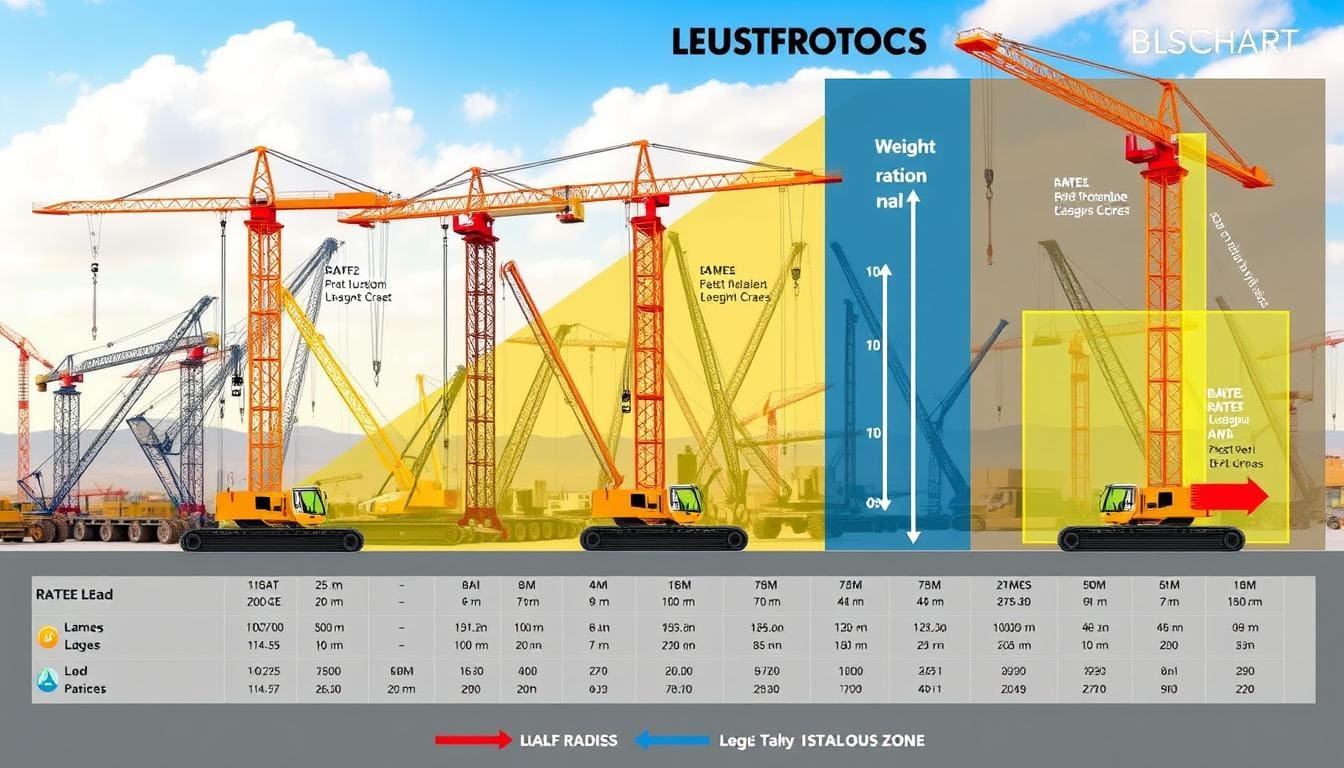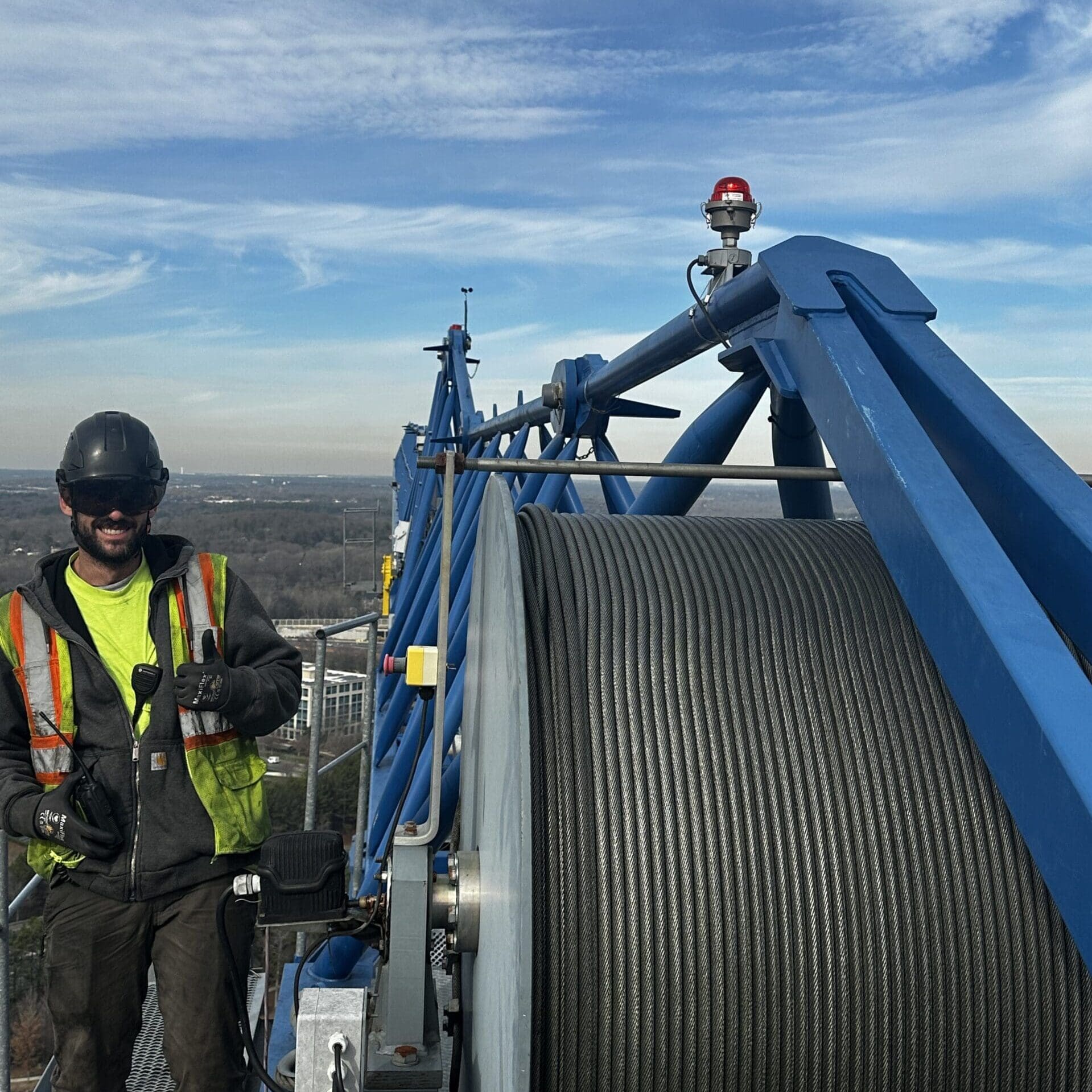A crane load chart is a key tool for safe and effective crane use. It shows the maximum weight a crane can lift at different distances. It also considers various operating conditions.
Knowing how to read this chart is crucial for crane operators and construction teams. It helps prevent overloads that could harm people and damage equipment. Following rules from OSHA and the National Commission for the Certification of Crane Operators (NCCCO) is important. It makes sure each lift is done safely.
Learn the Basics of Crane Load Charts
Crane load charts are key documents that show a crane’s lifting abilities. They help operators work safely and efficiently. These charts give vital information, like the maximum load a crane can lift under different conditions.
Knowing the crane’s specifications is crucial. It helps set realistic goals for lifting tasks. This knowledge is vital for safe and effective operations.
Every crane model has its own set of rules for what it can do. It’s important to know the difference between rated capacity and working load limit. The rated capacity is the highest load a crane can lift safely. The working load limit includes safety factors and changes in operation.
Knowing these terms helps operators follow safety guidelines. These guidelines come from trusted sources like the American National Standards Institute (ANSI) and the American Society of Safety Professionals.
The basics of crane load charts to avoid accidents and follow industry standards. Operators need to carefully look at the load charts for their equipment. This promotes safety and efficiency in the workplace.
Why Crane Load Charts Are Essential for Safety
Crane load charts are key to keeping workers safe during lifting. They help avoid accidents by showing the crane’s safe lifting limits. If these charts are ignored, it can lead to serious issues like crane tipping or injuries.
Using load charts correctly is not just about safety. It also meets legal requirements for a safe work area. Knowing how to use these charts helps create a safer work environment for everyone.
The Components of a Crane Load Chart
A crane load chart is key for safe and effective lifting. Knowing its parts helps keep operations safe and productive. The main parts are weight limits, radius measurements, and operating conditions.
Weight Limitations
Weight limits show the max weight a crane can lift safely. This part stops overloading. Overloading can cause damage or accidents, risking both the crane and people.
It’s crucial to stick to these limits for job site safety.
Radius Measurements
Radius measurements tell us how far from the crane’s center the load is. This distance affects how much weight can be lifted. The farther the load, the less weight can be lifted.
Knowing these limits helps plan lifts better.
Operating Conditions
Operating conditions include environmental factors that affect lifting. Things like wind, ground, and crane type matter. Checking these conditions helps make smart lift decisions.
How to Read a Crane Load Chart
Reading load charts is key for crane operation. It gives operators important info for safe lifting. Start by finding the crane model and its features on the chart. This helps understand the numbers and follow safety rules.
It’s important to know the lifting radius. Find the radius on the chart to see how far the load will lift. Then, check the weight limit to make sure the load is safe.
Make sure you know the units of measurement, like pounds or metric tons. Look for notes or warnings that add to safety. Using load charts right reduces risks and boosts efficiency.
Common Mistakes When Interpreting Load Charts
Understanding crane load charts is key for safe and efficient crane use. Many mistakes can happen while reading these charts, which can be dangerous. Fixing these errors can make job sites much safer.
Ignoring Load Limits
Ignoring the load limits in charts is a big problem. Going over these limits can cause serious damage and risk lives. It’s vital for operators to check the chart and stick to the limits to avoid accidents.
Misreading the Lifting Radius
Misunderstanding the lifting radius is another common error. This mistake can lead to wrong ideas about how much weight a crane can lift. Knowing how radius and weight relate is crucial for safe operation. By correctly reading load charts, operators can lift safely and reliably.
Crane Load Chart: Factors Affecting Load Capacity
It’s important to know what affects a crane’s load capacity for safe use. Several things can change how much weight a crane can lift. Terrain, ground conditions, and weather are two big factors.
Terrain and Ground Conditions
Crane stability can be affected by poor soil, uneven ground, or slopes. Before lifting, operators must check the site. Ignoring these details can be dangerous.
They should look at:
- Soil firmness and compaction
- Presence of slopes or uneven surfaces
- Potential for ground shifts during operation
Weather Conditions
Weather greatly affects crane performance, including wind, rain, and temperature. Extreme weather can make lifting unsafe. That’s why safety factors are in load charts for bad weather.
Important weather aspects to watch include:
- Wind speed and direction
- Precipitation levels
- Temperature extremes
How to Create a Crane Load Chart
Making load charts requires careful calculations. These must match the crane’s specifications. The process involves many factors, like the crane model and its setup. Also, the environment around the crane is very important.
Engineers must follow strict standards to get it right. Bodies like the ANSI and ASME give rules for safety and following the law. It’s key to make charts that are trustworthy.
The steps to make a load chart are:
- Collecting crane details, like how much it can lift and how far it can reach.
- Looking at the environment, like wind and how stable the ground is.
- Doing math to figure out how much weight it can handle in different situations.
- Writing down the results in a clear load chart.
The finished load chart is a crucial tool for everyone involved. It keeps lifting safe. Using special software can make creating load charts easier, giving better data for making choices.
Different Types of Crane Load Charts
It’s important for crane operators to know about different load charts. Each type is made for specific needs, making lifting safer and more effective. Here are the main types of load charts.
Mobile Crane Load Charts
Mobile crane load charts are key for cranes moving on different grounds. They show how lifting power changes with the crane’s position and the ground. Operators need to understand these charts well to work safely and efficiently.
Fixed Crane Load Charts
Fixed crane load charts are for cranes that stay in one place. They focus on the crane’s stability and how it handles loads when it’s not moving. Knowing how to read these charts helps operators keep loads within safe limits.
Practical Applications of Crane Load Charts
Crane load charts are essential in construction and industrial settings. They help operators check if cranes can lift certain loads safely. Knowing how to use these charts is key to planning and running projects well.
For example, load charts make it easier to assess risks by showing lifting capacities clearly. In construction, knowing these details helps teams work more efficiently. It lets them plan better and avoid delays.
- Enhances safety by ensuring operators know maximum load limits.
- Facilitates effective planning of lifting tasks through detailed insights.
- Promotes productivity by reducing errors in load handling.
- Assists in training new operators by providing a clear framework for safe lifting.
Crane load charts do more than just ensure safety. They play a big role in making construction projects run smoothly. Studies show that understanding these charts leads to better project outcomes.
Conclusion
Crane load charts is important to keeping lifting operations safe these charts are vital for safe and efficient construction work. By following safety rules, accidents can be greatly reduced, making the workplace safer.
It’s important to train people to use crane load charts correctly. Knowing how to read these charts helps crews understand what affects a crane’s load. This knowledge leads to a safer work environment and a culture of following rules.
Get certified as a crane operator with Certified Safety Experts and gain essential skills in interpreting load charts. Enhance safety, efficiency, and expertise in crane operations with our comprehensive certification program.
Knowing and using crane load charts well is crucial for safe lifting. Education and awareness help everyone in the team handle crane operations safely. This ensures every lift is done with care and precision.




